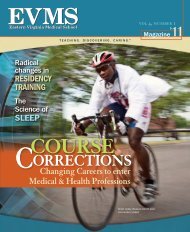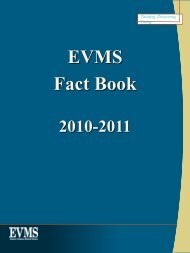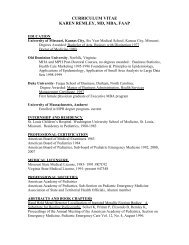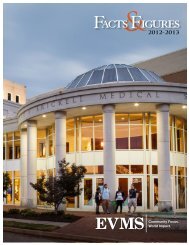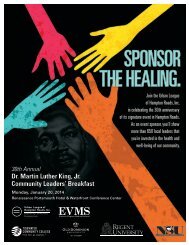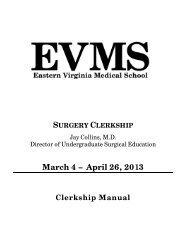in Hampton Roads in Hampton Roads - Eastern Virginia Medical ...
in Hampton Roads in Hampton Roads - Eastern Virginia Medical ...
in Hampton Roads in Hampton Roads - Eastern Virginia Medical ...
Create successful ePaper yourself
Turn your PDF publications into a flip-book with our unique Google optimized e-Paper software.
“We have an edge,”he expla<strong>in</strong>s. “That’s whythe center is so important. All ofour physicians are backed up by starendocr<strong>in</strong>ologists who can back up the entireoperation.”When Dr. Pepe became dean four years ago,a group of research advisors from outside theschool helped him p<strong>in</strong>po<strong>in</strong>t diabetes as a key areawhere the school had world-class expertise and thecommunity had significant needs. He established acenter dedicated to research <strong>in</strong>volv<strong>in</strong>g diabetes andobesity. The needs are enormous and <strong>in</strong>creas<strong>in</strong>g aspeople become more sedentary.Every year, diabetes leads to 96,000 amputationsand kills 213,000 <strong>in</strong> the U.S., nearly six times thenumber who die annually from the seasonal flu.A chronic condition, diabetes occurs when thepancreas either can’t produce enough <strong>in</strong>sul<strong>in</strong> orthe body doesn’t effectively use what it has. It isthe <strong>in</strong>dustrialized world’s lead<strong>in</strong>g cause of adultbl<strong>in</strong>dness and kidney failure. Every 10 seconds,someone dies from diabetes complications andtwo new patients are diagnosed, accord<strong>in</strong>g to theInternational Diabetes Federation.In <strong>Hampton</strong> <strong>Roads</strong>, at least 130,000 peoplesuffer from the disease, and half don’t know it untilcomplications, such as nerve damage, have occurred.It’s unclear what triggers the bodies of Type 1diabetics to destroy their own <strong>in</strong>sul<strong>in</strong>-produc<strong>in</strong>gcells, but obesity is l<strong>in</strong>ked to Type 2 diabetes. Type2 diabetes is strik<strong>in</strong>g people at such a young age thatit can no longer be referred to as adult-onset.“Now we’re look<strong>in</strong>g at children, adolescents,who may be adult-onset diabetics,” Dean Pepe says.“Normally, we thought of adult onset at [age] 55.”To head the new emphasis, Dr. Pepe recruitedJerry L. Nadler, MD, who had run the Divisionof Endocr<strong>in</strong>ology and Diabetes at the University ofVirg<strong>in</strong>ia.In his n<strong>in</strong>e years there, Dr. Nadler helpedgarner U.S. News & World Report rank<strong>in</strong>g for theU. Va. center. Sentara Norfolk General Hospital,<strong>in</strong> partnership with EVMS, recently made themagaz<strong>in</strong>e’s top 50 rank<strong>in</strong>g.EVMS offers Dr. Nadler the opportunity to workon juvenile diabetes, with the adjacent Children’sHospital of The K<strong>in</strong>g’s Daughters, as well as tocollaborate with the Veterans Adm<strong>in</strong>istration<strong>Medical</strong> Center <strong>in</strong> <strong>Hampton</strong> on diabetes <strong>in</strong> theelderly.L<strong>in</strong>k<strong>in</strong>gDiabetesand other DiseasesDr. Nadler, who is also chairman of the<strong>in</strong>ternal medic<strong>in</strong>e department, is research<strong>in</strong>g howsome genes may lead to the death of nervesand heart damage <strong>in</strong> diabetics.That could expla<strong>in</strong> why diabetic patientsoften lose their ability to walk, tend to falland have <strong>in</strong>tense pa<strong>in</strong>. Another relatedcomplication is ret<strong>in</strong>opathy, or nerve damageto eyes.“Some of the same gene family we believeis caus<strong>in</strong>g nerve disease might be caus<strong>in</strong>g eyedisease as well,” he says.Another focus of the center’s researchis heart disease. The Strelitz Center isplann<strong>in</strong>g to establish a special cl<strong>in</strong>ic atSentara Heart Hospital <strong>in</strong> Norfolk to focuson heart disease prevention and improvedtreatments for diabetics.They have a higher risk of heart diseasebut are often unaware of their diabetes, Dr. Nadlerexpla<strong>in</strong>s, add<strong>in</strong>g for many, “the first time they f<strong>in</strong>dout is when they have a heart attack.”EVMS researchers are <strong>in</strong>vestigat<strong>in</strong>g thel<strong>in</strong>ks between diabetes and heart disease<strong>in</strong> collaboration with the University ofVirg<strong>in</strong>ia and <strong>in</strong>vestigators <strong>in</strong> San Diegoas part of a grant funded by the NationalInstitutes of Health.Dr. Nadler’s personal <strong>in</strong>terest is <strong>in</strong>understand<strong>in</strong>g the l<strong>in</strong>k between the typeof obesity that leads to heart problemsand diabetes. He has a team look<strong>in</strong>g<strong>in</strong>to it that <strong>in</strong>cludes a scientist, SwarupChakrabarti, PhD and a post doctoralfellow, Banu Cole, MD.Diabetics are two to four times as likelyto die of a heart attack than the generalpopulation. Some component of that centralbody fat may be at fault, Dr. Nadler says.“What is learned <strong>in</strong> the labis translated <strong>in</strong>to patientcare. The patient has theadvantage of research at areally early stage.”Etta V<strong>in</strong>ikhead of Strelitz Diabetes Center’sEducation DivisionRichard Dollar19 years liv<strong>in</strong>g with diabetesTisha Jones29 years liv<strong>in</strong>g with diabetesdiabetes researchwww.eVMS.EDU Fall 200923




